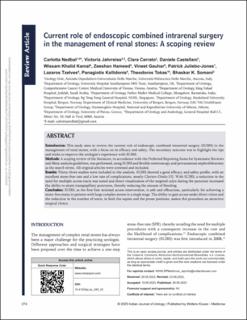| dc.contributor.author | Nedbal, Carlotta | |
| dc.contributor.author | Jahrreiss, Victoria | |
| dc.contributor.author | Cerrato, Clara | |
| dc.contributor.author | Castellani, Daniele | |
| dc.contributor.author | Kamal, Wissam Khalid | |
| dc.contributor.author | Hameed, Zeeshan | |
| dc.contributor.author | Gauhar, Vineet | |
| dc.contributor.author | Juliebø-Jones, Patrick | |
| dc.contributor.author | Tzelves, Lazaros | |
| dc.contributor.author | Kallidonis, Panagiotis | |
| dc.contributor.author | Tokas, Theodoros | |
| dc.contributor.author | Somani, Bhaskar K. | |
| dc.date.accessioned | 2024-01-29T14:24:18Z | |
| dc.date.available | 2024-01-29T14:24:18Z | |
| dc.date.created | 2023-11-30T12:37:54Z | |
| dc.date.issued | 2023 | |
| dc.identifier.issn | 0970-1591 | |
| dc.identifier.uri | https://hdl.handle.net/11250/3114366 | |
| dc.description.abstract | Introduction:
This study aims to review the current role of endoscopic combined intrarenal surgery (ECIRS) in the management of renal stones, with a focus on its efficacy and safety. The secondary outcome was to highlight the tips and tricks to improve the urologist’s experience with ECIRS.
Methods:
A scoping review of the literature, in accordance with the Preferred Reporting Items for Systematic Reviews and Meta-analysis guidelines, was performed, using ECIRS and flexible ureteroscopy and percutaneous nephrolithotomy as the search terms. All original articles were screened and included.
Results:
Thirty-three studies were included in the analysis. ECIRS showed a good efficacy and safety profile, with an excellent stone-free rate and a low rate of complications, mostly Clavien–Dindo I/II. With ECIRS, a reduction in the need for multiple access tracts was noted and direct visualization of the targeted calyx during the puncture increased the ability to attain transpapillary punctures, thereby reducing the amount of bleeding.
Conclusion:
ECIRS, as the first-line minimal access intervention, is safe and efficacious, particularly for achieving a stone-free status in patients with large complex stones in a single stage. The ability to gain access under direct vision and the reduction in the number of tracts, in both the supine and the prone positions, makes this procedure an attractive surgical choice. | en_US |
| dc.language.iso | eng | en_US |
| dc.publisher | Wolters Kluwer | en_US |
| dc.rights | Navngivelse-Ikkekommersiell-DelPåSammeVilkår 4.0 Internasjonal | * |
| dc.rights.uri | http://creativecommons.org/licenses/by-nc-sa/4.0/deed.no | * |
| dc.title | Current role of endoscopic combined intrarenal surgery in the management of renal stones: A scoping review | en_US |
| dc.type | Journal article | en_US |
| dc.type | Peer reviewed | en_US |
| dc.description.version | publishedVersion | en_US |
| dc.rights.holder | Copyright 2023 Indian Journal of Urology | en_US |
| cristin.ispublished | true | |
| cristin.fulltext | original | |
| cristin.qualitycode | 1 | |
| dc.identifier.doi | 10.4103/iju.iju_249_23 | |
| dc.identifier.cristin | 2206355 | |
| dc.source.journal | Indian Journal of Urology | en_US |
| dc.source.pagenumber | 274-284 | en_US |
| dc.identifier.citation | Indian Journal of Urology. 2023, 39 (4), 274-284. | en_US |
| dc.source.volume | 39 | en_US |
| dc.source.issue | 4 | en_US |

